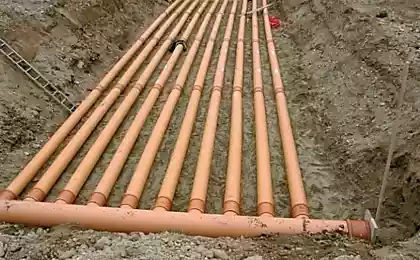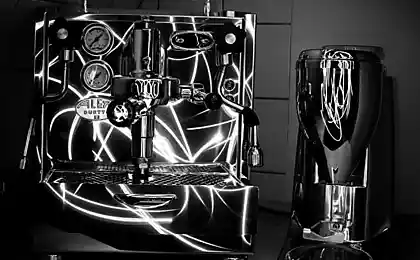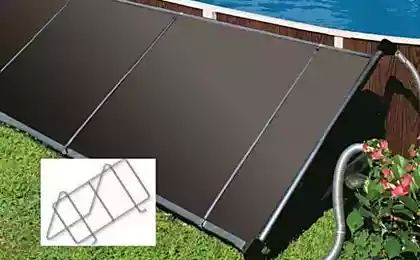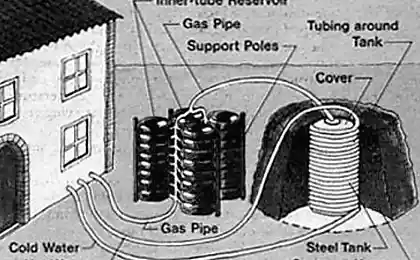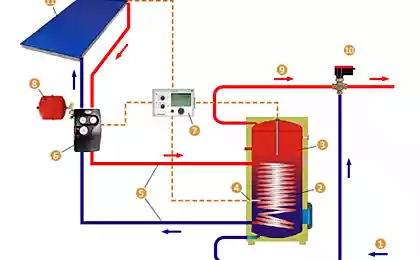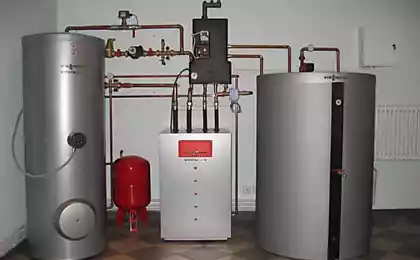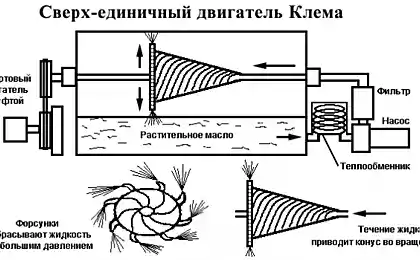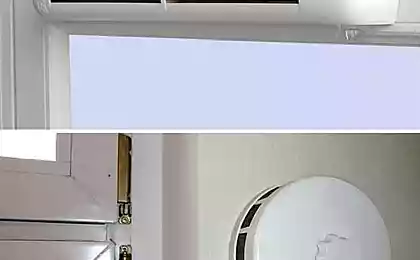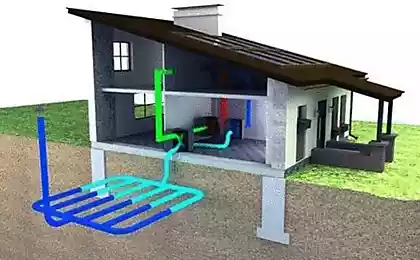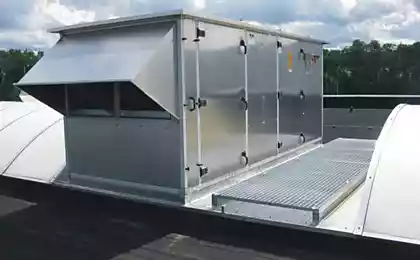575
The ground heat exchanger as an element of the ventilation system of the house
Wonderful addition of the ventilation system in any home will become the ground heat exchanger (TRP) — pipe, layer of gravel or membraneless exchanger, where there is a temperature inherent to the soil at a depth of 1.5-1.8 m, i.e. 4-8 ° C.
The outer air entering the heat exchanger is heated in winter and cooled in summer. So (for measurements at very low temperature), outside air temperature -22 °C was heated in the TRP, and at the entrance to the air duct in the house was up to + 2 °C. it is Clear that this temperature is not enough for heating, but the energy effect is quite significant (almost 20 °C — gift): this heat protects the ventilation system from freezing.
In the summer of TRP becomes effective the cooling system of the house, thereby eliminating the need for costly air conditioning. Qualitatively made, the TRP will cool the air from 32° C to 15 °C.
The principle of operation of ground heat exchangerBelow the freezing depth of soil (approximately 1.5 m) almost always keeps a constant temperature of 4-8 °C. in Fact this accumulated in the soil energy and goes to work, the TRP, where the air is in contact (indirectly or directly) with the soil. Depending on the temperature of the air entering the TRP, or its temperature rises (in winter) or decreased (in the summer).
In figures 1-2 illustrates the principles of operation of TRP at different times of the year.

Summer: the heat exchanger is suctioned through the TRP prepared by outside air that has already cooled (16 °C) when passing through the TRP. To avoid secondary heating of the air supplied to the room, the heat exchanger must be equipped with a bypass
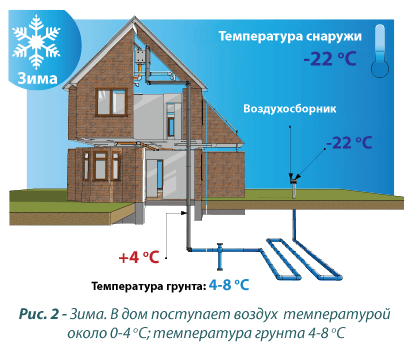
Winter: the heat exchanger is suctioned through the TRP prepared by outside air that is heated (usually 0-4 °C). The bypass of the heat exchanger must be shut down to air after TRP yet passed through the heat exchanger of the heat exchanger. Here, the TRP WIPONET function of the previous heater, free heating the incoming air and protecting the heat exchanger from freezing. The interaction of high level heat exchanger with TRP will ensure the supply of fresh air into the room, the temperature of which is close to the temperature of the room.
In recuperators of the last generation provides the function of programming the temperature limits of work of the TRP winter and summer. Automatic throttle valve with the servo motor regulates the movement of fresh air between the wall device for air intake and dirt (TRP).
The payback period TRPto Denote the payback period of the TRP is quite difficult. Of course, there is a program for fast calculation of energy saving, which provides the TRP. However, these data are exhaustively inform specialists and energy auditors, but almost nothing to say to the average customer.
The cost of the ventilation system with heat return for 1-7 years, depending on the house, type of ventilation and heating, etc. For homes in which the regenerative system is designed not with conventional gravity vented, but instead, this period is short: only a few months (if the cost of the system heat exchanger will take away funds that did not have to spend on chimneys, razgermetizatsii Windows, chimney nozzles, fans for bathrooms, etc.).
If the system is additionally equipped GTO, the payback can last up to several years, but it is not necessary to introduce in the column costs improving the quality of comfort, fresh indoor air, cooling the house in summer instead of expensive and energy-intensive climate system?! Just compare the cost at home, equipped with TRP, and homes with air-conditioning, it is possible to determine the real return on investment.
And most important: air conditioning is not able to provide effective air exchange in the room; the majority of air conditioning, "thresh" internal air cooling, external fresh air is not supplied here. This means that most air conditioners will not eliminate from the premises the allergens, dovrolis carbon or chemicals emitted, for example, paints and varnishes. System heat exchanger — TRP not only cools, but also supplies the fresh air, eliminates from the bathroom and toilet used. A similar effect give and air conditioning in the house equipped with a heat exchanger, effectively cooling the air than the TRP, but will consume huge amounts of energy.
Financial calculations (excluding comfort factor) indicate that the cost of the TRP return for 6-10 years, sometimes longer. If you think about the comfort of living, our health and "length" of accounts that have to pay for the work of energy-intensive air conditioning system, the TRP can be an investment with very short payback time – almost 1 to 4 years.
Types of ground heat exchangersPipe GTO
The easiest in the performance of TRP is just a plastic pipe with a length of 40-60 m, under the ground, which ends in an air inlet with a protective grid from insects and rodents, often and filter. For single-family homes most often used pipe with a diameter of 200 mm (for the area of 150-170 m2) or 250 mm (square 170-250 m2). For homes larger diameter of the TRP should be accurately calculated depending on the needs of ventilation in the house. A smaller pipe diameter for the implementation of the TRP. If the pipe diameter will be slightly larger than the diameter of the mounting fitting of the heat exchanger, the air flow ground heat exchanger will slow down; as a consequence, several to increase its performance — the air is better to heat in winter and cool in summer. If the pipe diameter is too large, the efficiency of the exchanger will drop as limited to the contact of air stream with the walls of the pipeline.
To complete the TRP should be used designed for this material; use of other materials may cause a significant decrease in its performance or cause leaks, and the TRP will constantly get wet.
Gravel TRP
This one GHE, which is used, when there was no pipe exchangers.
To perform gravel TRP is quite difficult and calls for special care and diligence to ensure the set parameters and to prevent formation of musty smell.
The basis of TRP is a layer of gravel that, along with the function of cooling in summer, and the previous heated air in the winter, performs the role of a filter for the air supplied to the house. A large part of the pollutants is retained in the layer of the heat exchanger, so from time to time, the gravel to be cleaned.
Sand the exchanger is of relatively high productivity. Done correctly, the TRP provides a guaranteed supply of fresh, filtered air into the house.
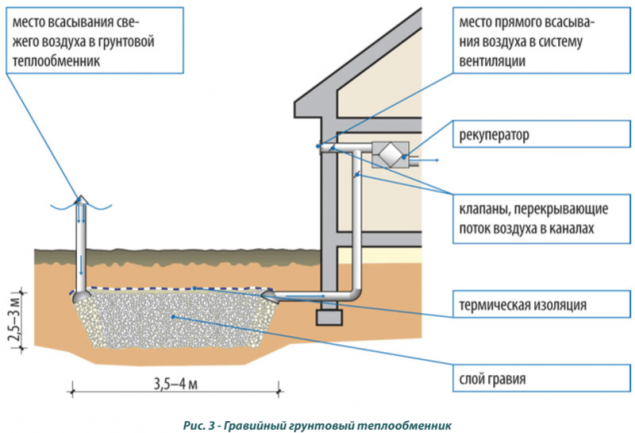
However, TRP has a number of disadvantages, which is worth remembering.
Gravel TRP is separated from the soil only by the geotextile, so there is danger of a leak in the water exchanger and even the ingress of rodents and insects. The presence of subsurface water at depths less than 2 m from the soil surface almost makes it impossible to use gravel TRP: treated water will block its work, will also become a factor in the intense musty smell, so you'll have to update the contents of the exchanger.
The gravel layer could not run continuously; its working mode need to be divided into two stages, 12 hours of operation 12 hours and recover the gravel layer. Recovery involves re-selecting and gravel with a layer of heat surrounding soil. Of course, for the pipe of the exchanger is also recommended mode of operation with interruptions, however, in pipe heat exchanger heat is recovered much faster than in the gravel with several tons of gravel.
If the gravel layer is not well rinsed before installation, or if during operation it gets wet (due to precipitation or rising groundwater), the TRP may be the source of a musty "basement" smell.
Gravel or membraneless TRP cannot be placed where there is an external load, for example due to traffic.
Damage to the top layer of the exchanger by compression can lead to performance degradation and moisture and, in turn, to the need for costly repairs.
The gravel layer is characterized by very large resistance to the air flow, so in most cases, TRP is necessary to equip an auxiliary fan with a capacity of up to several hundred watt (for more energy).
Losses on supports of air in the TRP if not carefully designed project of the ventilation system of the house and not exact calculations.
Sometimes the wrong vent Assembly and inner channels can be a factor too weak a little fresh air into the room. Therefore, performing a gravel TRP, you need to install an auxiliary fan (connected to the heat exchanger, which overcomes the inherent resistance of the gravel layer). However, the fan significantly reduces the energy saving characteristics of the system, in particular additionally consumes energy, whereas for the operation of tubular heat exchangers is sufficient fan power of the heat exchanger. When deciding on the design of the gravel TRP, you should consult with a specialist, especially in relation to resistance in fact the TRP and resistance of the ventilation system.
Nevertheless, the benefits of effectively organized TRP — tangible. Summer to the premises where installed the heat exchanger with a bypass, is served chilled air (whose temperature is 8-15 ° C below the outdoor temperature).
In the winter (if the system is with heat recovery) air enters at the Central fan unit is already preheated, effectively prevents the formation of frost on the heat exchanger of the heat exchanger and the shutdown of its electronic protection system against freezing. This eliminates the need to mount the system of the heat exchanger is more energy-intensive electric coil. The main result provides a heat exchanger effect of "free" cooling.

We should not forget that the so-called transitional periods, the ground heat exchanger should be switched off. Outdoor air during these periods removed "a long time" - collecting device on the wall.
After filling and leveling of the individual layers of gravel, laying of ducts and insulation top layer exchanger, the entire gravel layer is covered with soil of a thickness of about 80 cm
Free TRP
In the membraneless exchanger connected to the individual properties of pipe and gravel TRP. The principle of its implementation is to establish a layer of polymer plates on a flat layer of gravel.
Plate mounted on the "legs" resting on the surface of the gravel layer (gravel bedding). The air does not move through the gravel layer (as in gravel TRP), and above it — between the gravel and slabs.
Membraneless exchanger is guaranteed to operate for a long time without the need of regeneration, making maximum use of the heat of the soil.
Unlike gravel TRP-free does not create a large resistance to air flow.
Opted for a membraneless exchanger, it is necessary to remember:
the installation of a TRP should be left to professionals with experience, who will use the appropriate equipment. The manufacture of the heat exchanger himself could result in his injury and a significant reduction in productivity.
free TRP is not a dense design, so it cannot be applied in places where it happens the increase of groundwater level or probability of flooding of atmospheric precipitation;
cleanse free TRP (if necessary) as well as the gravel (digging — washing — re-styling). published
P. S. And remember, only by changing their consumption — together we change the world! ©
Join us in Facebook , Vkontakte, Odnoklassniki
Source: www.kep.systems/geothermal/gruntovoy-teploobmennik-kak-element-ventilyatsionnoy-sistemyi-doma
The outer air entering the heat exchanger is heated in winter and cooled in summer. So (for measurements at very low temperature), outside air temperature -22 °C was heated in the TRP, and at the entrance to the air duct in the house was up to + 2 °C. it is Clear that this temperature is not enough for heating, but the energy effect is quite significant (almost 20 °C — gift): this heat protects the ventilation system from freezing.
In the summer of TRP becomes effective the cooling system of the house, thereby eliminating the need for costly air conditioning. Qualitatively made, the TRP will cool the air from 32° C to 15 °C.
The principle of operation of ground heat exchangerBelow the freezing depth of soil (approximately 1.5 m) almost always keeps a constant temperature of 4-8 °C. in Fact this accumulated in the soil energy and goes to work, the TRP, where the air is in contact (indirectly or directly) with the soil. Depending on the temperature of the air entering the TRP, or its temperature rises (in winter) or decreased (in the summer).
In figures 1-2 illustrates the principles of operation of TRP at different times of the year.

Summer: the heat exchanger is suctioned through the TRP prepared by outside air that has already cooled (16 °C) when passing through the TRP. To avoid secondary heating of the air supplied to the room, the heat exchanger must be equipped with a bypass

Winter: the heat exchanger is suctioned through the TRP prepared by outside air that is heated (usually 0-4 °C). The bypass of the heat exchanger must be shut down to air after TRP yet passed through the heat exchanger of the heat exchanger. Here, the TRP WIPONET function of the previous heater, free heating the incoming air and protecting the heat exchanger from freezing. The interaction of high level heat exchanger with TRP will ensure the supply of fresh air into the room, the temperature of which is close to the temperature of the room.
In recuperators of the last generation provides the function of programming the temperature limits of work of the TRP winter and summer. Automatic throttle valve with the servo motor regulates the movement of fresh air between the wall device for air intake and dirt (TRP).
The payback period TRPto Denote the payback period of the TRP is quite difficult. Of course, there is a program for fast calculation of energy saving, which provides the TRP. However, these data are exhaustively inform specialists and energy auditors, but almost nothing to say to the average customer.
The cost of the ventilation system with heat return for 1-7 years, depending on the house, type of ventilation and heating, etc. For homes in which the regenerative system is designed not with conventional gravity vented, but instead, this period is short: only a few months (if the cost of the system heat exchanger will take away funds that did not have to spend on chimneys, razgermetizatsii Windows, chimney nozzles, fans for bathrooms, etc.).
If the system is additionally equipped GTO, the payback can last up to several years, but it is not necessary to introduce in the column costs improving the quality of comfort, fresh indoor air, cooling the house in summer instead of expensive and energy-intensive climate system?! Just compare the cost at home, equipped with TRP, and homes with air-conditioning, it is possible to determine the real return on investment.
And most important: air conditioning is not able to provide effective air exchange in the room; the majority of air conditioning, "thresh" internal air cooling, external fresh air is not supplied here. This means that most air conditioners will not eliminate from the premises the allergens, dovrolis carbon or chemicals emitted, for example, paints and varnishes. System heat exchanger — TRP not only cools, but also supplies the fresh air, eliminates from the bathroom and toilet used. A similar effect give and air conditioning in the house equipped with a heat exchanger, effectively cooling the air than the TRP, but will consume huge amounts of energy.
Financial calculations (excluding comfort factor) indicate that the cost of the TRP return for 6-10 years, sometimes longer. If you think about the comfort of living, our health and "length" of accounts that have to pay for the work of energy-intensive air conditioning system, the TRP can be an investment with very short payback time – almost 1 to 4 years.
Types of ground heat exchangersPipe GTO
The easiest in the performance of TRP is just a plastic pipe with a length of 40-60 m, under the ground, which ends in an air inlet with a protective grid from insects and rodents, often and filter. For single-family homes most often used pipe with a diameter of 200 mm (for the area of 150-170 m2) or 250 mm (square 170-250 m2). For homes larger diameter of the TRP should be accurately calculated depending on the needs of ventilation in the house. A smaller pipe diameter for the implementation of the TRP. If the pipe diameter will be slightly larger than the diameter of the mounting fitting of the heat exchanger, the air flow ground heat exchanger will slow down; as a consequence, several to increase its performance — the air is better to heat in winter and cool in summer. If the pipe diameter is too large, the efficiency of the exchanger will drop as limited to the contact of air stream with the walls of the pipeline.
To complete the TRP should be used designed for this material; use of other materials may cause a significant decrease in its performance or cause leaks, and the TRP will constantly get wet.
Gravel TRP
This one GHE, which is used, when there was no pipe exchangers.
To perform gravel TRP is quite difficult and calls for special care and diligence to ensure the set parameters and to prevent formation of musty smell.
The basis of TRP is a layer of gravel that, along with the function of cooling in summer, and the previous heated air in the winter, performs the role of a filter for the air supplied to the house. A large part of the pollutants is retained in the layer of the heat exchanger, so from time to time, the gravel to be cleaned.
Sand the exchanger is of relatively high productivity. Done correctly, the TRP provides a guaranteed supply of fresh, filtered air into the house.

However, TRP has a number of disadvantages, which is worth remembering.
Gravel TRP is separated from the soil only by the geotextile, so there is danger of a leak in the water exchanger and even the ingress of rodents and insects. The presence of subsurface water at depths less than 2 m from the soil surface almost makes it impossible to use gravel TRP: treated water will block its work, will also become a factor in the intense musty smell, so you'll have to update the contents of the exchanger.
The gravel layer could not run continuously; its working mode need to be divided into two stages, 12 hours of operation 12 hours and recover the gravel layer. Recovery involves re-selecting and gravel with a layer of heat surrounding soil. Of course, for the pipe of the exchanger is also recommended mode of operation with interruptions, however, in pipe heat exchanger heat is recovered much faster than in the gravel with several tons of gravel.
If the gravel layer is not well rinsed before installation, or if during operation it gets wet (due to precipitation or rising groundwater), the TRP may be the source of a musty "basement" smell.
Gravel or membraneless TRP cannot be placed where there is an external load, for example due to traffic.
Damage to the top layer of the exchanger by compression can lead to performance degradation and moisture and, in turn, to the need for costly repairs.
The gravel layer is characterized by very large resistance to the air flow, so in most cases, TRP is necessary to equip an auxiliary fan with a capacity of up to several hundred watt (for more energy).
Losses on supports of air in the TRP if not carefully designed project of the ventilation system of the house and not exact calculations.
Sometimes the wrong vent Assembly and inner channels can be a factor too weak a little fresh air into the room. Therefore, performing a gravel TRP, you need to install an auxiliary fan (connected to the heat exchanger, which overcomes the inherent resistance of the gravel layer). However, the fan significantly reduces the energy saving characteristics of the system, in particular additionally consumes energy, whereas for the operation of tubular heat exchangers is sufficient fan power of the heat exchanger. When deciding on the design of the gravel TRP, you should consult with a specialist, especially in relation to resistance in fact the TRP and resistance of the ventilation system.
Nevertheless, the benefits of effectively organized TRP — tangible. Summer to the premises where installed the heat exchanger with a bypass, is served chilled air (whose temperature is 8-15 ° C below the outdoor temperature).
In the winter (if the system is with heat recovery) air enters at the Central fan unit is already preheated, effectively prevents the formation of frost on the heat exchanger of the heat exchanger and the shutdown of its electronic protection system against freezing. This eliminates the need to mount the system of the heat exchanger is more energy-intensive electric coil. The main result provides a heat exchanger effect of "free" cooling.

We should not forget that the so-called transitional periods, the ground heat exchanger should be switched off. Outdoor air during these periods removed "a long time" - collecting device on the wall.
After filling and leveling of the individual layers of gravel, laying of ducts and insulation top layer exchanger, the entire gravel layer is covered with soil of a thickness of about 80 cm
Free TRP
In the membraneless exchanger connected to the individual properties of pipe and gravel TRP. The principle of its implementation is to establish a layer of polymer plates on a flat layer of gravel.
Plate mounted on the "legs" resting on the surface of the gravel layer (gravel bedding). The air does not move through the gravel layer (as in gravel TRP), and above it — between the gravel and slabs.
Membraneless exchanger is guaranteed to operate for a long time without the need of regeneration, making maximum use of the heat of the soil.
Unlike gravel TRP-free does not create a large resistance to air flow.
Opted for a membraneless exchanger, it is necessary to remember:
the installation of a TRP should be left to professionals with experience, who will use the appropriate equipment. The manufacture of the heat exchanger himself could result in his injury and a significant reduction in productivity.
free TRP is not a dense design, so it cannot be applied in places where it happens the increase of groundwater level or probability of flooding of atmospheric precipitation;
cleanse free TRP (if necessary) as well as the gravel (digging — washing — re-styling). published
P. S. And remember, only by changing their consumption — together we change the world! ©
Join us in Facebook , Vkontakte, Odnoklassniki
Source: www.kep.systems/geothermal/gruntovoy-teploobmennik-kak-element-ventilyatsionnoy-sistemyi-doma
10 superorganic with kettlebells
Top 9 books for the development of creativity and creative thinking
